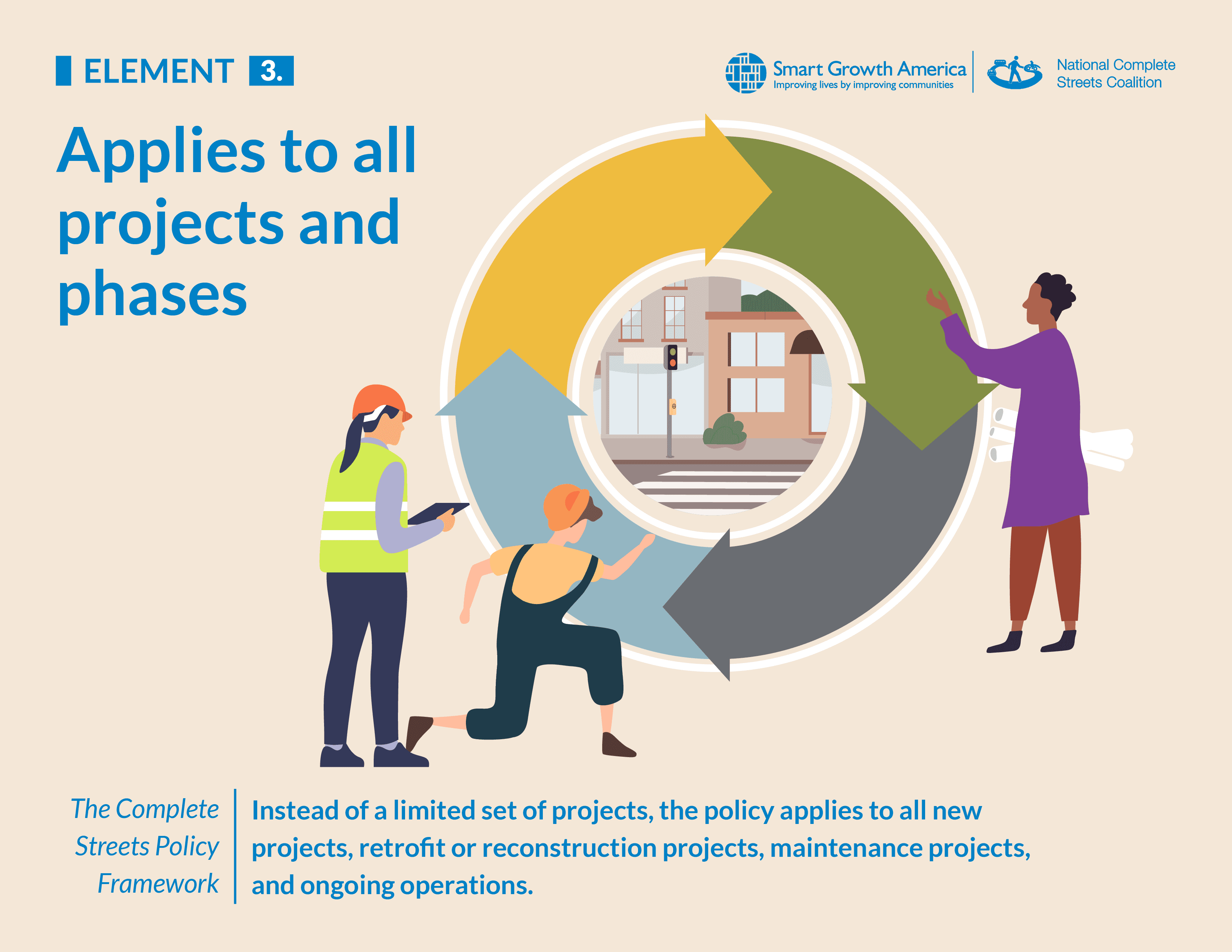
News
By Steve Davis, April 24, 2023
To which projects or streets should a Complete Streets policy apply? If the policy is a strong one, then it dictates a holistic approach to every transportation project, in every place, in every phase of work. This means the application of a policy will also look different based on context.

Why is this element integral to a strong Complete Streets policy?
There are two big reasons that our policy framework includes this third element requiring that any policy applies to all projects and phases.
First, Complete Streets is not just a set of projects, it’s a holistic approach and process to the transportation system, which by definition, applies to all kinds of projects.

Getting to Complete Streets requires more than just isolated projects here and there. It requires building a complete network of streets that are safe for all users. Doing this demands a new paradigm to the entire transportation system, so a strong policy will be applied to every project, not just the “convenient” ones, for example. (Exceptions may sometimes exist, but we cover that in more detail in element #4)
Second, Complete Streets are never just an add-on component or a design feature tacked on at the end of the same old conventional road-building project. The strongest, most effective policies apply to every phase of any project’s development, including planning, design, construction, operation, and maintenance. Instead of, for example, applying Complete Streets elements after a project’s purpose has already been scoped or defined, such as tacking on some features late in the design process.
What does this element look like in practice?
<
The policy element is very clear that every transportation project—including every maintenance operation—accounts for the needs of all modes of transportation and users of the road network.
Instead of applying only to certain projects or a narrowly defined set of projects, the strongest Complete Streets policy requires the consideration of all users for all new, retrofit/reconstruction, maintenance, and ongoing projects. (A weaker policy merely considers these projects as opportunities for applying these principles.) This might mean integrating a Complete Streets approach into existing maintenance schedules and using basic repaving work to improve the overall network, rather than just waiting on large, expensive, capital projects. While the requirement to consider all users does not mean all modes will be equally accommodated in the final project, it does mean that motor vehicles are not presumed as the primary mode and it should demonstrate a foundational culture shift in the department or agency.
Whether a repaving or more expansive construction project, this work can also be disruptive to people using the street. Under the typical status quo, the needs of people outside of cars are generally not carefully considered or accounted for when the right-of-way gets ripped up or temporarily blocked. That’s why this element also specifies the need to provide safe and routine accommodations during any construction or repair work that infringes on the right-of-way and/or sidewalk. E.g, a city’s Complete Streets policy would codify a requirement that when a sidewalk is closed for adjacent construction, the property owner/developer must provide a sidewalk that’s comparable to the one being temporarily removed. In an urban area that might mean a sheltered sidewalk to protect people from nearby construction. In a less dense suburban or rural area, that might just mean an adjacent sidewalk of the same width and quality.
Policy scoring details
In our framework for evaluating and scoring Complete Streets policies, this element is worth a total of 10 out of 100 possible points.
For municipality/county policies:
- 4 points: Policy requires all new construction and reconstruction/retrofit projects to account for the needs of all modes of transportation and all users of the road network.
- (1 point) Policy considers or mentions these projects as opportunities to apply this policy.
- (0 points) No mention.
- 4 points: Policy requires all maintenance projects and ongoing operations, such as resurfacing, repaving, restriping, rehabilitation, or other types of changes to the transportation system to account for the needs of all modes of transportation and all users of the road network.
- (1 point) Policy considers or mentions these projects as opportunities to apply this policy.
- (0 points) No mention.
For state/MPO policies:
- 4 points: Policy requires all new construction and reconstruction/retrofit projects receiving state or federal funding, to account for the needs of all modes of transportation and all users of the road network.
- (1 point) Policy considers or mentions these projects as opportunities to apply this policy.
- (0 points) No mention.
- 4 points: Policy requires all maintenance projects and ongoing operations, such as resurfacing, repaving, restriping, rehabilitation, or other types of changes to the transportation system receiving state or federal funding to account for the needs of all modes of transportation and all users of the road network.
- (1 point) Policy considers or mentions these projects as opportunities to apply this policy.
- (0 points) No mention.
For all policies:
- 2 points: Policy specifies the need to provide accommodations for all modes of transportation to continue to use the road safely and efficiently during any construction or repair work that infringes on the right-of-way and/or sidewalk.
Related News

© 2025 Smart Growth America. All rights reserved
Site By3Lane Marketing


























